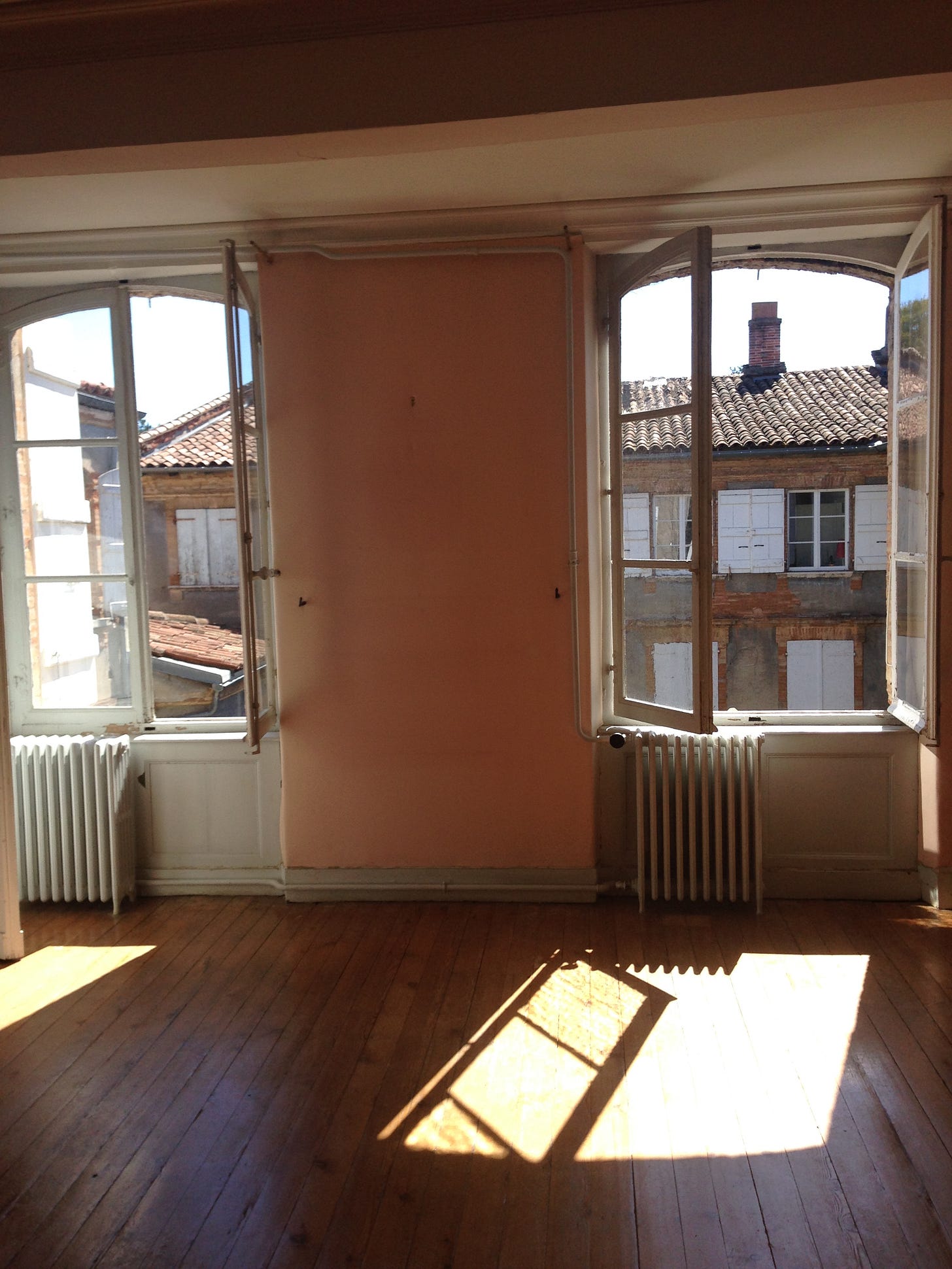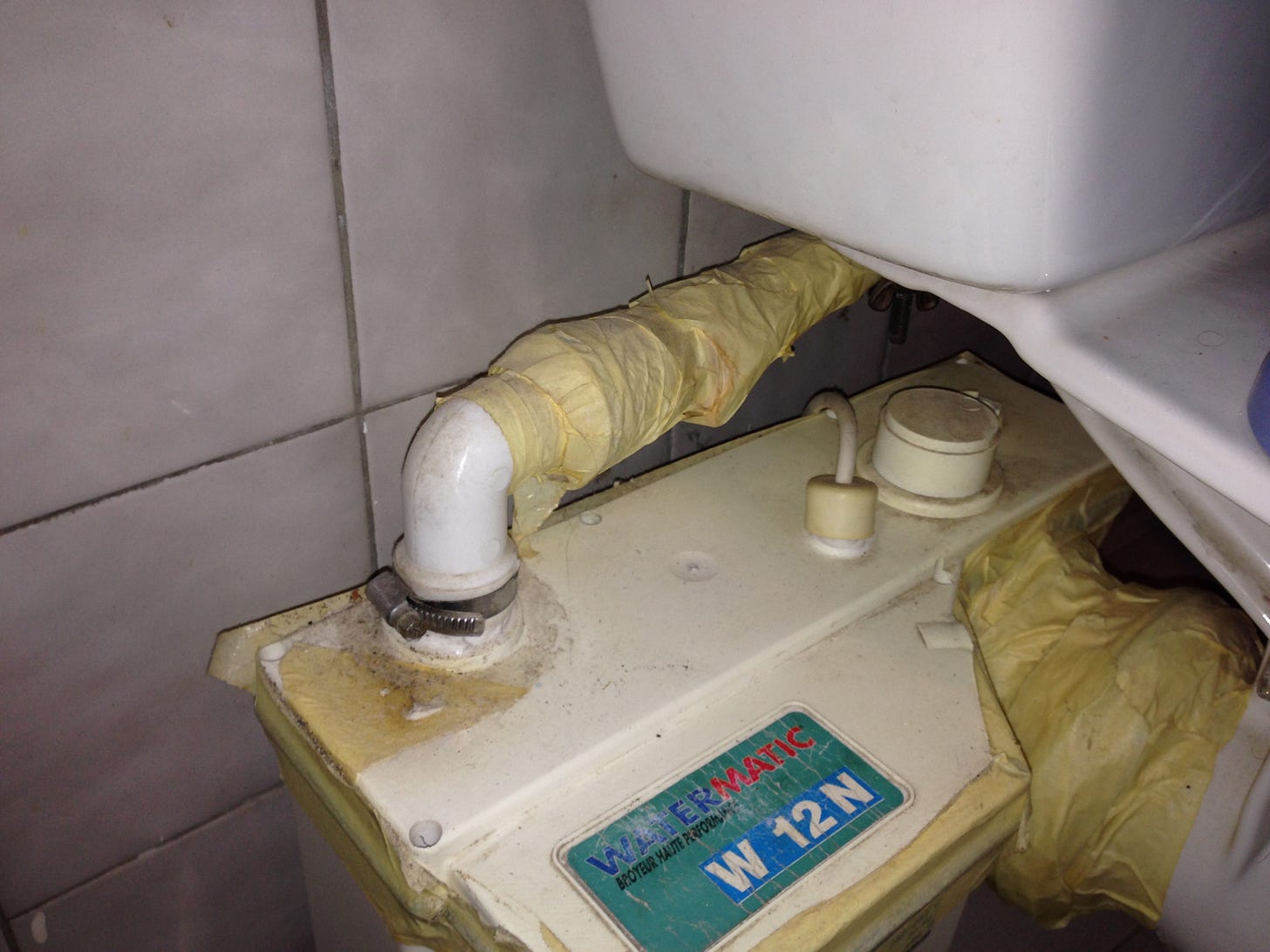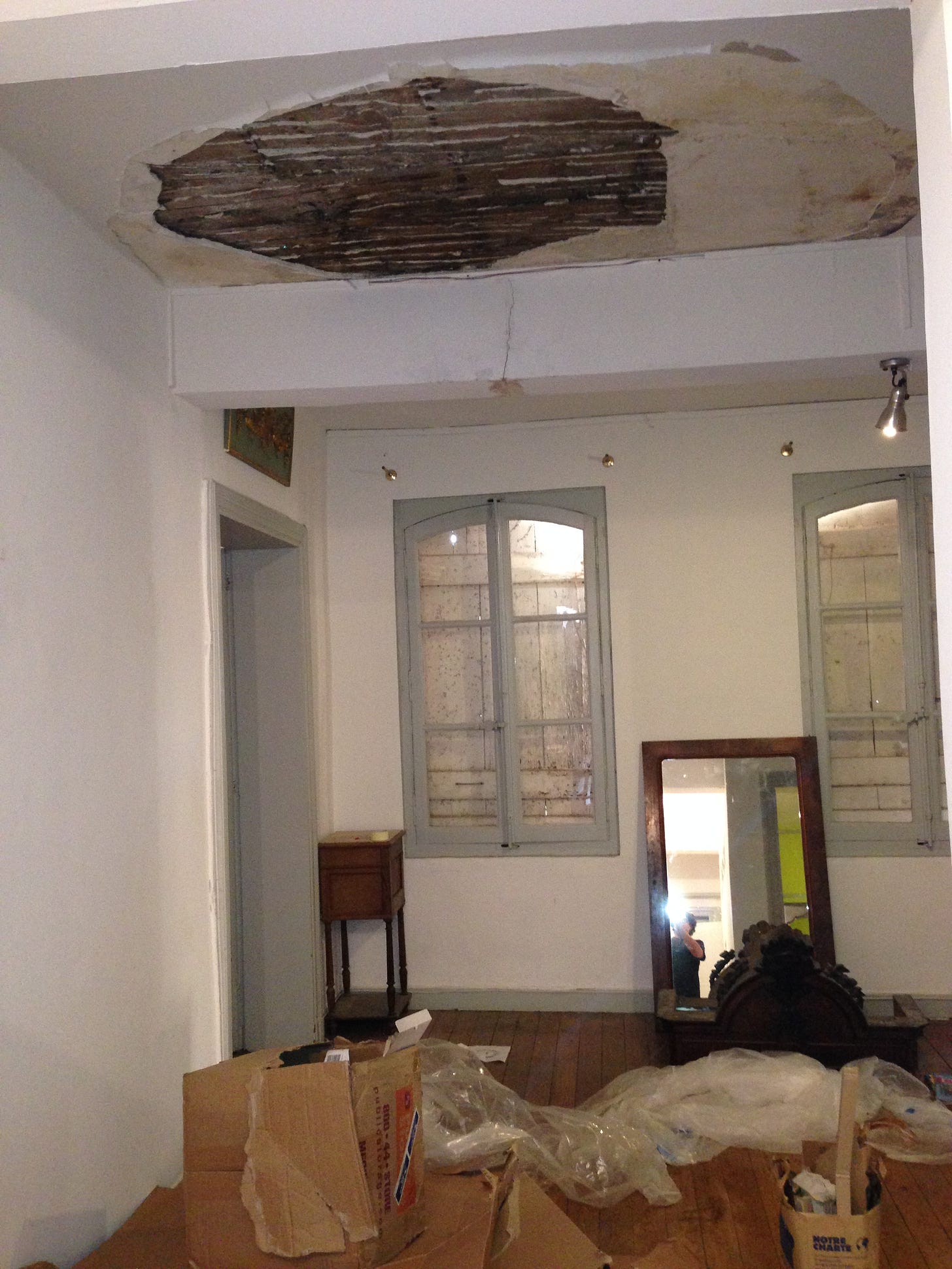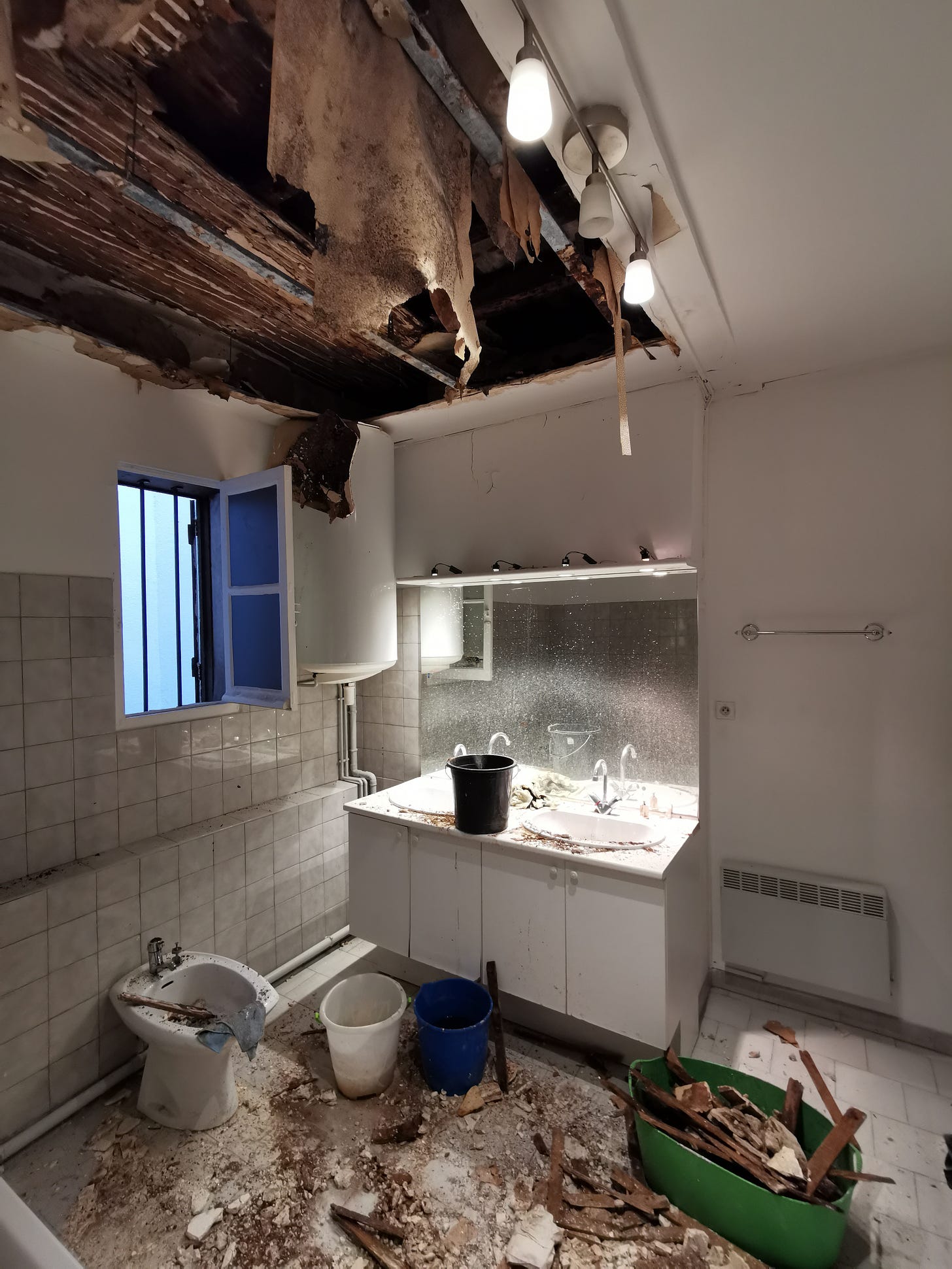Loving And Loathing L'Appartement
How does one say 'shabby chic' in French?
As I described previously, our Toulouse apartment is a strange beast. We grew to love it dearly. Yet even if we find many aspects of it to be wonderful, it is still nonetheless bizarre, cavernous, and even dangerous at times.
The building is perhaps 400 to 500 years old (we think). The interior of the apartment was more modern than the building. But often, it didn’t seem by much. When we first visited the apartment, a family with several young children was still living there, and so their rugs and furniture covered many of the faults we would only discover later. Clearly, the owners and their agents hadn’t invested much in keeping it up.
We liked to tell people that it was shabby chic, a phrase for which I’ve struggled to find a French equivalent. Perhaps vétuste is the closest I’ve come, but that just means dilapidated. It doesn’t quite capture the fact that it was also stylish and historic in its own way. But yes, also dilapidated and not well maintained.
The wood floor in the living room had several select creaks which could be ear piercing, leaving us wondering whether it was going to hold. It also seemed to be less an assortment of flood boards and more a loosely-held-together collection of splinters. Anyone walking across it barefoot inevitably paid the price and we have spent many hours over the years picking splinters out of each other’s feet.
The plumbing seemed to be theoretical. In the kitchen, there was a space for a dishwasher and washing machine. Their drainage pipes all converged with a narrow PVC pipe for the sink. I learned early on that running more than one at a time would overload the narrow pipe and flood the pock-marked linoleum floor.
That PVC drainage pipe exited through a small hole in the kitchen wall and then ran down along the side of the apartment into the alley below and then the sewage system. Alas, this grey pipe mounted against the exterior of the building was an endless temptation for the teenage hoodlums from the Catholic school down the street. They loved to loiter in the alley and climb on the pipe, which would inevitably tear away from the wall. Our wastewater would be flooding the alley for several days before someone would alert us so we could call the agents to get it fixed.
Near the bedroom on the main floor was the toilet which didn’t have sufficient water pressure, and so required a machine that was part grinder and part pump to…facilitate things. This was installed with a unique bit of craftsmanship:
These were annoyances and inconveniences. Sometimes both, as when the toilet grinder died and flooded the bathroom. And as many friends have pointed over the years, this is the price to be paid for living in a historic neighborhood. The rent was reasonable in part because of these faults. When window panes popped while we were cleaning them out and smashed to pieces in the courtyard below because the molding had rotted away, wasn’t that just part of the adventure? The agents for our apartment clearly dealt with these issues constantly across the rentals they managed and were never surprised by anything.
Fair enough. But in some cases, these problems were also dangerous.
Heating this place costs a fortune, not helped by those ancient windows that do not completely close, and requires careful management of the various radiators to prevent a truly astronomical bill. One winter, however, the heater kept cutting off, and no one could figure out why. After visits from several repair people, one of them finally detected the cause. It turned out the ducts that emptied the carbon monoxide from the heater took it not outside, but to the front room of the apartment! We had been blasting carbon monoxide into the apartment for almost 2 years and we’re lucky it didn’t kill us.
The Hole(s) In The Ceiling (Parts I And II)
The first time we toured the apartment during our July 2014 visit, someone pointed to a small brown stain on the ceiling in the front hall and explained that some water had recently started dripping but it would soon be fixed and no need to worry.
Upon returning to the U.S., we informed the agent we wanted the apartment and began a long exchange of paperwork. Unfortunately, we learned that because we were foreigners, we had to deposit 6 months of rent (on top of first and last months’ rent and a one-month security deposit) in advance as a guarantee. If we fled the country at some point, they wanted to make sure the owners had some way to sue us and get their hands on our money. An unexpected expense, but we bit our lips, and sent the money and the contracts. And that seemed to be that until a couple of weeks before we were set to move. An email from the agent landed in our inboxes.
That little water issue had not been fixed, and that brown stain in the ceiling was now a small hole. As we were now in August, everyone was on vacation. There was nothing to be done about it until September.
By the time we moved into the apartment in late August, the hole was more than a foot across. And growing. Initially, we put some boxes around the space underneath to make sure no one walked under it. Over the next month, it continued to expand as more and more plaster crumbled and tumbled to the floor. Sounds of splitting, and cracking, followed by bits of plaster crashing to the ground and exploding became part of our daily routine. Finally, in mid-September, an agent for the apartment’s owner came to inspect the hole, looked at it carefully, nodded, and agreed that, yes, there was indeed a hole in the ceiling. The next step seemed rather obvious to us: Fix the hole. As soon as possible. But in France, there is a single, right way to do pretty much everything. And fixing the hole immediately was not the way such things are done here, we were told.
More urgent was the need to figure out the source of the problem. Because only by knowing the source could one know who to blame. And assigning blame was the real priority. Was this the result of a leak from the roof, and therefore the responsibility of the syndic, the person who represented the building on behalf of all the apartment owners? Or was this the result of a broken pipe inside the apartment, and therefore a problem for the apartment owner?
Meanwhile, I kept trying to suggest that it might save everyone money in the long run to fix the hole and leak now and then figure out the payment-responsibility-blame thing later. The longer we waited, the bigger the hole would get and the more expensive to fix. Oh no, we were told, this is just how it’s done here. Over the next several weeks, we hosted a series of visits by inspectors representing all parties and their respective insurance companies, to determine the source and assign blame. In the end, the diagnosis was a leaky roof, and so the syndic sent some repair people to look and give an estimate for the roof work. After that was repaired, a second work group arrived later to fix the ceiling. And so finally, in late October, three months after the leak was first spotted, the gaping hole in the ceiling was closed.
We would relive this episode several years later in more dramatic fashion when the small brown stains in the bathroom ceiling began to spread and then produce periodic dripping. In addition to our own apartment being a maze, the way it connects to the neighboring apartments is also warren-like. For instance, there is an apartment above us, a tiny unit that is only accessible from the apartment below us. One enters the lower apartment and then climbs a makeshift staircase that runs through the middle of our apartment and is thankfully hidden behind walls. But hearing someone clomp-clomp-clomping up and down the stairs as if they were marching through our living room became a regular feature of life.
When the bathroom began to leak, we assumed it was likely from the apartment above, whose shower was directly above our bathroom. This set off a three-year hunt for the source of the leak, with several plumbers insisting that there was no leak above us. Agents periodically scrambled across rooftops to see if it was coming from the exterior. What someone should have done was open our bathroom ceiling to find the source, but everyone seemed mainly interested in avoiding this.
Instead, we were locked in a three-way stalemate between the woman who owned the downstairs and upstairs apartments, the agents for our apartment, and the syndic. At one point, the neighboring building’s syndic was implicated (but later exonerated) for having put in a plastic awning that was routing water onto our building’s roof.
Everyone did their best to ensure that the blame did not land on them, and meanwhile the leak returned again and again and fissures spread across the ceiling. Fearing it would collapse, we abandoned it in November 2019, sealing the doors. A month later, in the middle of the might, it collapsed.
This belatedly triggered another round of visits from artisans and insurance people from the various parties. In early March 2021, an enterprising new plumber arrived on the scene and discovered the source: The shower above us.
It turned out that previous plumbers had passed water with dye through the drain, and since it didn’t seep into our bathroom ceiling, they figured the shower wasn’t the culprit. However, the new plumber noticed that the shower’s caulking was chipped degraded. He poured some colored water through a space between some tiles, and sure enough, it ran straight into our bathroom.
A timely bit of caulk several years earlier could have avoided the catastrophe. Thanks to the pandemic and the first national French lockdown, it would take 4 more months before anyone could come to the apartment to rebuild the ceiling.





